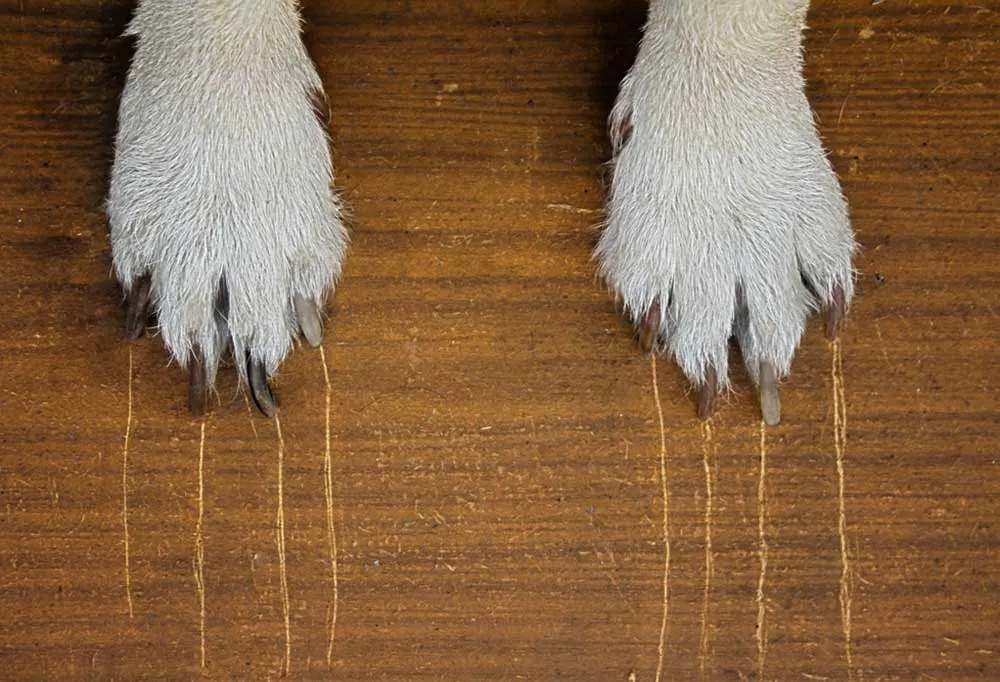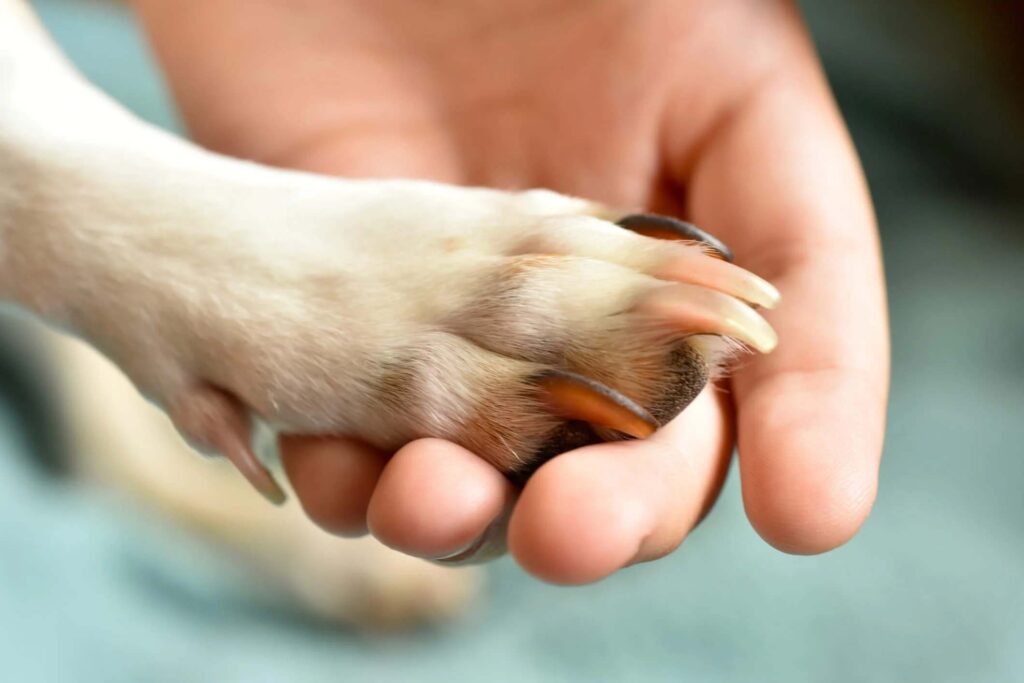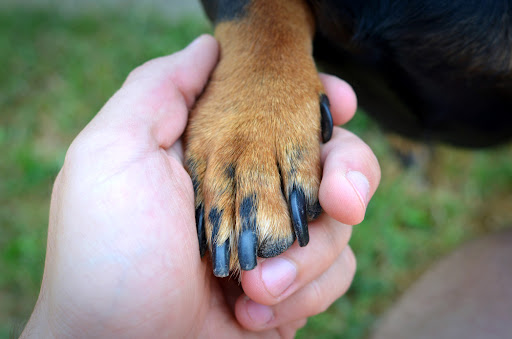Noticing your dog’s nail changing color can be worrying, especially if it turns black, red, or brown. While nail color can naturally vary between dogs and breeds, sudden changes may point to injury, infection, or an underlying health issue.
Your dog’s nail may turn black from natural pigmentation, aging, or hyperpigmentation. However, sudden darkening can signal fungal or bacterial infections, trauma, or underlying health issues. A vet visit ensures safe and accurate diagnosis.
In this guide, we’ll explore the common reasons behind nail discoloration, when you should worry, and how to keep your dog’s nails safe, healthy, and strong with proper care and timely veterinary attention.
Dog nails come in various colors depending on the breed, age, and pigmentation. Some dogs are born with white or clear nails, while others have brown or black ones. Mixed-colored nails are also common.
To understand why nails may change color, it helps to know their structure:
- Keratin shell: The hard outer layer that protects the nail.
- Quick: The inner part that contains blood vessels and nerves.
- Nail bed: The tissue underneath the nail, where infections or tumors may develop.
A black nail may be natural pigmentation. However, if your dog has light-colored nails now turning black, it may suggest trauma, infection, or another condition worth investigating.

Some dogs naturally have black nails due to their breed or genetics. It’s completely safe and doesn’t need treatment.
If your dog’s nails have always been dark, it’s likely pigmentation. However, watch for other symptoms or discomfort if the color changes suddenly.
As dogs age, their nails can change color like fur or skin. A slow darkening of the nails is usually harmless and part of aging. You don’t need to worry about this change if your dog shows no pain, swelling, or signs.
If a nail gets caught, cracked, or bruised, it may turn black from dried blood under the surface. This usually happens after rough play, long walks, or nail accidents.
While mild injuries heal independently, watch for swelling, bleeding, or limping and see your vet if needed.
Infections can darken a dog’s nail, making it brittle, smelly, or painful. Your dog may lick the paw often or limp.
These infections don’t go away by themselves and usually need veterinary care, such as antibiotics or antifungal medication, to clear the problem and prevent spreading.
Sometimes, dogs react to things like cleaning products, lawn chemicals, or food. This can cause inflammation around the nails, leading to changes in color over time.
Keeping paws clean, using pet-safe products, and working with your vet to manage allergies helps protect your dog’s nails.
A tumor in the nail bed can change the nail’s color, cause abnormal growth, or make the nail brittle. It may also lead to bleeding or swelling around the toe.
Since some tumors are cancerous, it’s essential to see a vet immediately if you notice these signs.
Specific health problems, like autoimmune diseases or immune suppression, can affect nail color and growth.
These conditions often show other signs, such as hair loss, skin irritation, or fatigue. A vet check is essential if multiple nails suddenly change color or your dog seems unwell.
Read More: How Much Baby Aspirin Can I Give My Dog: Vet Advice Inside
Not always. In many dogs, black nails are completely normal. However, if you notice sudden changes in nail color—especially in just one nail—it’s worth paying closer attention.
To help you decide, here’s a quick comparison:
| Normal Causes | Concerning Causes |
| Breed genetics | Nail turning black suddenly |
| Aging | Pain, swelling, or limping |
| Gradual darkening | Nail breaking, falling off, or bleeding |
| Multiple nails dark from puppyhood | Pus, foul odor, or discharge |

- Limping or avoiding weight often means the nail is painful, possibly from trauma, infection, or swelling.
- Swelling, redness, or tenderness are classic signs of inflammation or infection that shouldn’t be ignored.
- Bleeding, Pus, or foul odor – Indicates infection or a damaged nail bed that needs professional treatment.
- Sudden color change – A nail turning black overnight can point to trauma, bleeding, or, in rare cases, a tumor.
- Excessive licking or chewing – Dogs do this to soothe pain or irritation, often a sign that the paw is uncomfortable or infected.
- Calmly restrain your dog and inspect the paw.
- Clean the area with a mild saline solution or a diluted antiseptic (such as chlorhexidine or povidone-iodine), and then pat it dry.
- If bleeding, apply direct pressure for several minutes; then use styptic powder or cornstarch to help clot. (Styptic powder is preferable; bar soap can help in a pinch.)
- Wrap the paw with sterile gauze or a light bandage if needed to keep it clean. Change the bandage daily.
- Prevent your dog from licking the toe — use an e-collar or bootie if necessary.
If the wound continues to bleed, the dog won’t bear weight, the toe rapidly swells, or there’s a foul smell or pus, take your dog to the vet immediately.
Just like coat and eye color, nail shade is influenced by genetics. Some dogs are born with naturally black or dark nails, while others have lighter ones. It’s safe and usually not a cause for concern.
Certain breeds tend to have darker nails due to stronger pigmentation. For example, Rottweilers and Labradors often grow black nails, while lighter breeds may show clear or white nails. Breed-related nail color is entirely standard.
A sudden change in nail color may signal issues like trauma, infection, or, in rare cases, a tumor. If nails become painful, swollen, or bleed, you must visit your vet to check for problems early.
You Should Know: Why Dogs Cough After Drinking Water – Vet-Approved Guide!
If your dog’s nail turns black suddenly, becomes painful, or shows swelling, bleeding, or foul odor, it’s time to see a vet.
These can be signs of infection, trauma, or even a nail tumor. Waiting too long may make things worse.
A vet can diagnose the cause quickly, prescribe safe treatment, and prevent complications. Always trust your instincts—if your dog seems uncomfortable, don’t delay professional care.
If the dark nail isn’t painful and your dog seems fine, safe home care can help. Keep the nails trimmed regularly to prevent cracks, and gently clean your dog’s paws after walks to remove dirt or chemicals.
For minor injuries, rinse with an antiseptic solution and monitor for changes. Avoid harsh products and always use pet-safe cleaners.
Home care works best for mild issues, but a vet visit is still essential if you notice worsening symptoms.
Treatment depends on why the nail has turned black. Minor trauma may only need trimming and cleaning until it heals.
Infections usually require antibiotics or antifungal medication prescribed by a vet. Allergies may be managed with diet changes or antihistamines, while nail tumors often need surgical removal.
The proper treatment plan should always come from your veterinarian, since guessing at home can worsen things. Getting the correct care early helps your dog heal faster and stay comfortable.

- Trim nails regularly – Long nails are likelier to snag, crack, or split. Keeping them short reduces pressure on the paw and lowers the risk of painful injuries.
- Choose safe walking surfaces – Hot pavement, icy sidewalks, or rough gravel can damage paw pads and nails. Walking on grass or smooth ground is safer for nail health.
- Clean paws after outdoor play – Washing away dirt, bacteria, or chemicals helps prevent infections and irritation that can lead to nail discoloration.
- Keep nails dry – Moist environments encourage fungal growth. Drying paws after swimming, rain, or baths helps protect the nail bed from infection.
- Feed a balanced diet – Strong nails need nutrients like protein, biotin, and omega-3 fatty acids. A quality diet supports healthy nail growth and reduces brittleness.
- Use pet-safe products – Harsh cleaners, fertilizers, or de-icers can irritate paws and nails. Switching to pet-safe options prevents allergic reactions and long-term nail problems.
A dog’s nails may turn black from natural pigmentation, aging, or health issues like trauma, infection, or tumors.
If the color change happens gradually and your dog is comfortable, it’s usually harmless. A vet should check sudden, painful changes.
Red nails often mean irritation, trauma, or infection around the nail bed. This could happen from allergies, rough surfaces, or excessive licking.
Redness paired with swelling or bleeding is a warning sign, and a veterinarian should examine the paw.
Brown nails can develop from staining, mild fungal infections, or natural pigment changes. Sometimes saliva from frequent licking can also discolor the nail. If your dog shows pain, odor, or cracking, a vet visit helps rule out infection.
Read Must: Does My Dog Know I’m Sick – 10 Ways They Sense Illness!
A nail turning black suddenly may point to bruising, bleeding inside the nail, or a more serious problem like infection or tumor. Quick color changes are never regular—schedule a vet appointment to ensure your dog stays safe.
Many dogs naturally have a mix of black and white nails due to genetics or pigmentation. This is completely safe and common, especially in mixed breeds. This variation isn’t a concern as long as your dog’s nails are healthy.
Reddish-brown nails are often linked to infection or saliva staining from constant licking. Treatment depends on the cause—antifungal or antibiotic medication may be prescribed, along with paw cleaning and avoiding irritants. Always let a vet guide proper treatment safely.

After an injury, blood may pool under the nail, making it look black or purple. The nail might fall off as a new one grows back. Please keep it clean, trim gently, and ask your vet about pain relief or treatment.
Trimming black nails can be tricky because you can’t see the quick. Use minor, careful cuts with proper clippers, stopping when you spot a gray oval. If unsure, ask your vet or groomer to trim them safely.
If your dog is limping with a black toenail, it could mean trauma, infection, or even a tumor affecting the nail bed.
Limping signals pain, so don’t wait—have your veterinarian examine the paw to prevent worsening problems.
- A dog’s nails can naturally be black due to genetics or age.
- Sudden blackening may point to trauma, infection, or tumors.
- Watch for pain, swelling, odor, or limping—these need veterinary care.
- Healthy nail care includes regular trimming, clean paws, pet-safe products, and a balanced diet.
- When in doubt, always consult your veterinarian for safe and timely treatment.
Discolored nails may come from natural pigment, aging, or health issues like infections or trauma. If the change is sudden or painful, a vet check is essential.
Nail color can change with age, genetics, or health problems. Gradual changes are often regular, but your vet should check for sudden darkening or pain.
An infected nail may look swollen, red, or discolored, sometimes with Pus or foul odor. Your dog might lick it often or show signs of pain.
Clean the nail gently with pet-safe antiseptic and keep it dry. Avoid home antibiotics. If swelling, pain, or discharge continue, your vet must treat it appropriately.
Unhealthy nails may be brittle, cracked, thickened, or oddly colored. If they bleed, cause limping, or have foul odor, it’s best to seek veterinary help quickly.
Dogs get black nails from injury, infection, or natural pigment. Treatment depends on the cause: cleaning, medication, trimming, or vet care for serious problems.
Black nails may mean bruising, infection, or aging changes. Treatment includes gentle cleaning, antifungal or antibiotic medicine, or trimming. A vet helps if pain continues.
Unhealthy claws look cracked, brittle, overgrown, discolored, or painful. They may bleed, split, or cause limping. Healthy nails should be smooth, strong, and evenly shaped.
A bacterial infection typically presents with redness, swelling, pus, a bad odor, and painful nails. The nail may darken or loosen. Dogs often lick the infected claw repeatedly.
A dog’s nail turns black from pigment, trauma, infection, or rarely tumors. If it’s sudden, painful, or smelly, it’s best to see the veterinarian quickly.
Noticing your dog’s nail turning black can feel unsettling, but the cause isn’t always serious. For many dogs, dark nails are simply part of their natural pigmentation or a harmless change with age. Still, sudden discoloration, pain, swelling, or odor should never be ignored, as these can point to injury, infection, or even more serious conditions. The safest step is to monitor changes and seek veterinary advice when something seems unusual. With proper nail care, secure walking habits, and timely vet visits, you can protect your dog’s paws and keep them comfortable, active, and healthy.
